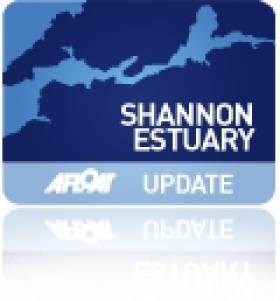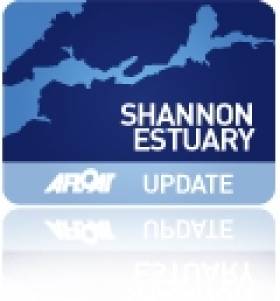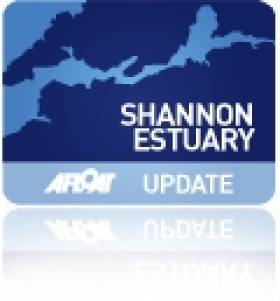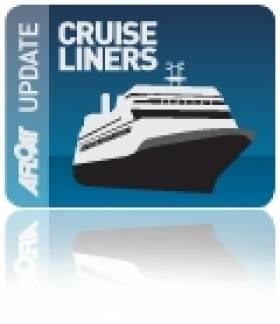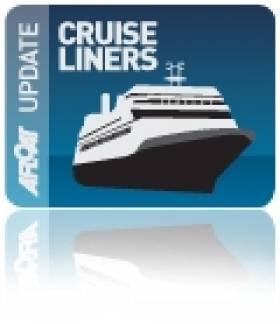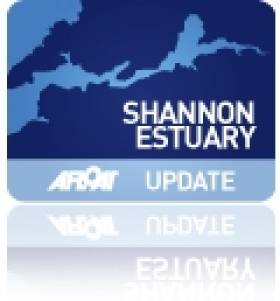Displaying items by tag: Shannon Estuary
#MARINE WILDLIFE - The Limerick branch of Birdwatch Ireland is seeking volunteers to assist in rescuing birds from oil spillages in the Shannon Estuary.
A report in the Limerick Post recounts a recent meeting at Shannon Rowing Club, where Birdwatch Ireand highlighted the impact on the environment and marine wildlife from both major and minor oil spills.
The meeting also discussed the role that local birdwatchers can play in determining crucial spillage incident response times.
A training exercise at Poulnasherry Bay is being organised for next month using equipment donated to the Irish Seal Sanctuary, preceeded by a similated planning exercise and "on-the-ground response".
The Irish Seal Sanctuary will also provide opportunities for training in the rehabilitation and cleaning of spillage-affected birds.
The Limerick Post has much more on this story HERE.
Foynes Yacht Club Prepares for Jubilee Year
#FOYNES – Preparations are getting under way at Foynes Yacht Club for the golden jubilee of the club this year.
On Sunday, January 22 a traditional Irish music session will take with the group, Creeves Wrenboy's taking to the stage at 5pm for what promises to be a spectacular event of music and song.
In Feburary and March a series of lectures will take place on nautical activities, and these will take place on Wednesday evenings; the adult and junior sailing courses are beginning in March, and the annual boat flotilla to Limerick for the Riverfest celebrations on the May Bank Holiday weekend will take place.
The lift-in day for all craft is scheduled for Saturday, April 14 at 10am.
In April a gala going Afloat will take place. Further details on this event will be posted on the club website shortly.
A mass for deceased members of the club, and members will be said in February, the date is not confirmed yet, but members are asked to keep an eye to the club website.
The main focus is on the West of Ireland Offshore Racing Championship's, which will take place in July, and a target on 50 boats for the event is planned. already an entry of 42 craft have put pen to paper, and it is hoped that 50 vessels will take part. Other events planned are Glin Castle race, the Estuary Bell race, Carrigaholt race, the Cappa race, the the Club regatta, which coincides with the Foynes Irish Coffee festival, and other fringe events.
Masterplan for Shannon Foynes Port Company
Port expansion options are to be examined so to prepare ports for larger trade volumes when the opportunities arise. Also under consideration are the non-core assets at the Port of Foynes and Limerick Docks. To read more about the masterplan and the challenges and issues that has been identified in both ports click HERE.
The statutory jurisdiction of the estuary is under the control of SFPC, which is responsible for the estuary that runs from the mouth entrance marked by Kerry and Loop Heads and stretching far inland to Limerick City. The natural waterway can handle vessels of up to 200,000 deadweight tonnes (dwt) which are the largest ships that can dock in Irish waters.
Cargo Ships Collide in Shannon Estuary
The second vessel, the 93-metre Danish-registered Tina Theresa, was leaving the anchorage to meet up with the Shannon estuary pilot when the collision took place. The tanker was destined for Foynes Port in Limerick and was damaged along her starboard side but there was no hull damage.
Small Luxury Cruiseship Visits Killybegs
In 2004 Killybegs received a significant boost in the completion of a €50m outer harbour with berthing quays totalling 350-metres long so to accommodate the north-west fleet and to include the 'supertrawlers'.
Despite the major port infrastructural investment, Killybegs has seen declining fortunes in the fish industry though in recent year's new business from the offshore exploration and cruise ship industries has assisted in generating new revenue.
Record Profits for Foynes Port as Tonnage Increases
The boost is revealed in the state-owned company's annual report which shows the facility made a bottom-line profit for the year of €1.1 million – a five-fold increase on 2009. Operating cash flows rose to €3 million, up from €2.7 million a year earlier. To read more click HERE.
Late last month the Co. Limerick port was busy particularly with the seasonal arrival of three cruise ships and all made within one week, for more click HERE. This Friday sees the return of one of those cruise-callers, the French-flagged Le Diamant which is on charter to operator Inter Cruises.
Cruise-Goers Head for the Galway Races
The vessel first visited Galway in 2009 but this call will be her last year operating under the Spirit of Adventure cruise banner. The company are to replace the vessel next season with the Saga Pearl II which will be transferred from the parent company Saga Cruises and renamed Quest for Adventure.
Prior to the Spirit of Adventurer's call, the 226 passenger Le Diamant arrived from St. Malo last Friday. She became the first vessel to make a call to the 'City of the Tribes' on behalf of her French operators, Cie de Ponant. Her passengers were taken on tours of the city, Connemara and the Aillwee Caves in neighbouring Co. Clare. The vessel is due to return early next month.
With three cruise-calls this year the port is set to increase this figure to 7 in 2012 arising from the ports campaign over the last two years. Paul Carey, Chairman of the Harbour Company, said "We are beginning to see the fruits of this campaign and look forward to growing Galway's association with the return of the majestic passenger liners to Galway".
"The passenger liner The World has been confirmed for a two-day visit in August 2013 which is a great endorsement of Galway as a cruise destination".
The call by the world's first ocean-going luxury resort vessel will also be another first for Galway. Operators of the 43,524gt vessel, Residences at Sea have made previous Irish ports of call to include Dublin, for more on her to the capital last August click HERE.
- Dublin Port
- Galway Bay
- Foynes
- Shannon Estuary
- The World
- Cruiseships
- Ports and Shipping News
- city of the tribes
- Galway Harbour
- Galway Harbour News
- Mutton Island
- Le Diamant
- Cruiseliners
- Saga Cruises
- Spirit of Adventure Cruises
- Spirit of Adventure
- Galway Harbour and Bay news
- Galway Port
- Port of Galway Company
- Ponant Cruises
- Galway Races
- The Galway Races Ballybrit
- Ballybrit Race Course
- Port of Foynes
- Saga Pearl II
- Quest for Adventure
- Shannon Estuary and port news
- The World cruise liner
- Residences at Sea
- The World Residences at Sea
- Irish cruise ports of call
- Irish cruise calls
- Cruiseships to Ireland
- Cruise Companies visiting Ireland
- West of Ireland cruise callers
Loop Head: A Guiding Light for Foynes-Bound Cruise Calls
Her arrival will be followed by P&O Cruises latest addition Adonia on Saturday. With 710 berths the 30,000 tonnes vessel is the smallest of the seven-strong fleet which can accommodate between 1,800 and up to 3,100 passengers as in the case of the Azura. The 115,000 tonnes vessel departed Dublin Port this evening. Her first call to the port was last year (click HERE) and she is the largest cruise ship to call to the capital.
On Tuesday of next week the 9,000 tonnes Spirit of Adventure (cruises) marks the third cruise caller to Foynes. The port is along with five other terminals located throughout the country's largest estuary are operated by the Shannon Foynes Port Company (SFPC).
Incidentally Spirit of Adventure and Azura where two of another trio of cruise ships that visited the Port of Cork on Monday, with Holland America Line's 59,000 tonnes Rotterdam forming the third vessel. This was the first occasion that Cork has handled this number of cruise ships on a single day, bringing 7,000 passengers which set a new record for the port.
- Shannon Estuary
- Shannon Foynes Port Company
- P&O Cruises
- Loop Head
- Cruiseships
- lighthouses
- Dublin Port news
- Holland America Line
- Port of Cork News
- Le Diamant
- Cruiseliners
- Spirit of Adventure
- Shannon Estuary news
- Loop Head Lighthouse visitor centre
- Azura cruise ship
- Spirit of Adventure cruiseship
- Adonia cruiseship
- Rotterdam cruiseship
- Loop Head Lighthouse
- Shannon Estuary and River
- Shannon Estuary and River news
- Lighthouse news
- Irish cruise calls
- Irish ports of call
- Foynes Port
Foynes Prepares for Gold Leaf Trophy
The current holder of this trophy in the club is Brian O'Donnell, won last year on his yacht, Whyte Dolphin. Weather permitting it is expected that 10 yachts from Foynes Yacht Club will be competeing for line honours.
Members of Tralee Bay Sailing Club are due to sail to Cooleen Point on Friday to participate in the race. First gun will be a 9am start. On Sunday a cruise up the estuary is organised, where hopefully a spot of fishing will take place.
The first leg of the Estuary Bell race was cancelled last weekend due to the very strong winds, which were gusting 4 to 6.
The organisers, Cruiser Class Captain, Alan McEneff and Sailing Secretary, Liam Madden made the right decision in calling of the race for the safety of all competitors involved. It will be pencilled in the sailing calendar during the summer.
It is anticipated that a 'full house' sign will be the order of the day for Commodore's Day, on Sunday, May 29. Commodore Tom Murray, who has been at the 'helm' for the last few year's in the club is expecting a 'bumper' show of members, in what can only be described as the ultimate date in the calendar at Foynes Yacht Club.
Commodore's Day is open to all classes of craft, and racing will have a 2pm start. The blessing of the boats will take place at the marina after racing, and this task will be performed by Canon O'Keeffe and Fr. Noonan.
Galway J109 Crew are Superleague Performers
Glen Cahill and the crew of the J109 Joie de Vie from Galway Bay Sailing Club were crowned overall winners of the West Coast Super League 2010 in both IRC & Echo at the prize giving held last Saturday night at Foynes Yacht Club.
The Murphy Marine Services sponsored league was an extracted series of seven events on the West Coast of Ireland and is organised by the West of Ireland Offshore Racing Association with the help from various clubs involved which where Galway Bay Sailing Club, Tralee Bay Sailing Club, Clifden Boat Club, Foynes Yacht Club and the Royal Western Yacht Club of Ireland.

Simon Mc Gibney (WIORA Commodore) Glen Cahill, Jennifer Cuddy, Chris Law, Bobbi O Regan (WIORA) Bernard McCarthy. More prizegiving photos below
The events where the Tralee Bay Sailing Club Regatta, West Coast Championships hosted by the Royal Western Yacht Club, O'Sullivan Marine 100 Mile Race, Clifden Boat Club Regatta, Galway Bay Sailing Club Regatta, Northwestern Offshore Racing Association Regatta hosted by Galway Bay Sailing Club and Foynes Yacht Club Regatta.
In excess of sixty boats took part in the various events during the League and the final placing where not decided until the Foynes Yacht Club Regatta was completed.
Joie de Vie had a very impressive season wining Class 1 in no less than four of the seven events including the West Coast Championships and fought off stiff competition from Raymond McGibney's Dehler 34 Disaray from Foynes Yacht Club, who finished overall runner up in both IRC & Echo and Liam Burke's Corby 33 AWOL from Galway Bay Sailing Club who collected the most competed events WIORA Trophy and Rob Allen's Corby 36 Mustang Sally from the Royal Western Yacht Club of Ireland.
Results after all seven events completed -
Overall IRC & ECHO
Overall IRC & ECHO Winner – Glen Cahill's J109 Joie de Vie Galway Bay Sailing Club
Overall IRC & ECHO Runner up - Raymond Mc Gibney Dehler 34 Disaray Foynes Yacht Club
Class Prize & The most competed events WIORA Trophy
Liam Burke's Corby 33 AWOL Galway Bay Sailing Club
Class Prize
Rob Allen Corby 36 Mustang Sally Royal Western Yacht Club of Ireland

Awol: Bobbi O Regan (WIORA) Nigel Thornton, Noreen Mc Carthy, Simon Mc Gibney (WIORA Commodore)

Disaray Crew: Simon Mc Gibney (WIORA Commodore) Edward Enright, Fionn Mc Gibney, Louise Barrett, Rory Mc Gibney, Bobbi O Regan (WIORA) Raymond Mc Gibney

Mustang Sally: Simon Mc Gibney (WIORA Commodore), Rob Allen, Bobbi O Regan (WIORA)




























